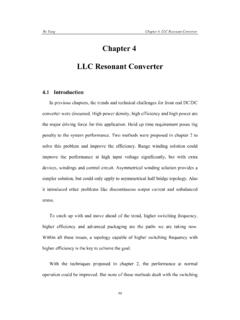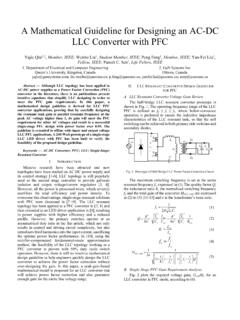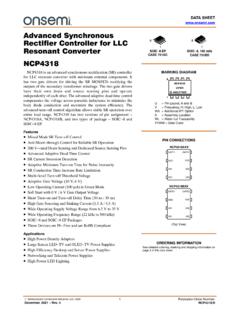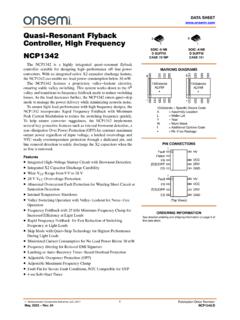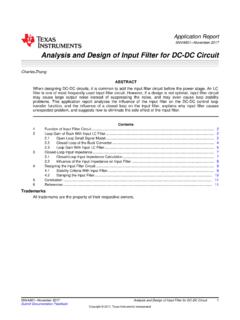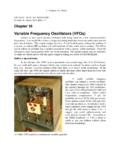Transcription of Design Considerations for an LLC Resonant Converter
1 Considerations for an LLC Resonant ConverterHangseok ChoiPower Conversion Team21. Introduction Growing demand for higher power density and low profile in power Converter has forced to increase switching frequency However, Switching Losshas been an obstacle to high frequency operationCapacitive lossReverse recovery lossOverlap of voltage and currentHigh frequency operation31. Introduction Resonant Converter : processes power in a sinusoidal manner and the switching devices are softly commutated9 Voltage across the switch drops to zero before switch turns on (ZVS) Remove overlap area between V and I when turning on Capacitive loss is eliminated Series Resonant Converter / Parallel Resonant converter41. Introduction+VO-RoQ1Q2n:1 IpLrLmCrIds2 VdVin Resonant networkSeries Resonant (SR) Converter The Resonant inductor (Lr) and Resonant capacitor (Cr) are in series The Resonant capacitor is in series with the load 9 The Resonant tank and the load act as a voltage divider DC gain is always lower than 1 (maximum gain happens at the Resonant frequency)9 The impedance of Resonant tank can be changed by varying the frequency of driving voltage (Vd)51.
2 IntroductionSeries Resonant (SR) Converter Advantages9 Reduced switching loss and EMI through ZVS Improved efficiency9 Reduced magnetic components size by high frequency operation Drawbacks9 Can optimize performance at one operating point, but not with wide range of input voltage and load variations 9 Can not regulate the output at no load condition9 Pulsating rectifier current (capacitor output): limitation for high output current application61. Introduction+VO-RoQ1Q2n:1 IpLlkpCrIds2 VdVin Resonant networkParallel Resonant (PR) Converter The Resonant inductor (Lr) and Resonant capacitor (Cr) are in series The Resonant capacitor is in parallel with the load 9 The impedance of Resonant tank can be changed by varying the frequency of driving voltage (Vd)71. Introduction Advantages9No problem in output regulation at no load condition9 Continuous rectifier current (inductor output): suitable for high output current application Drawbacks9 The primary side current is almost independent of load condition: significant current may circulate through the Resonant network, even at the no load condition9 Circulating current increases as input voltage increases: limitation for wide range of input voltageParallel Resonant (PR) converter81.
3 Introduction What is LLC Resonant Converter ?9 Topology looks almost same as the conventional LC series Resonant converter9 Magnetizing inductance (Lm) of the transformer is relatively small and involved in the resonance operation 9 Voltage gain is different from that of LC series Resonant Converter +VO-RoQ1Q2n:1 IpLrLmCrIds2 VdImIDVin Resonant networkIo+VO-RoQ1Q2n:1 IpLrLmCrIds2 VdVin Resonant networkLC Series Resonant Converter LLC Resonant converter91. Introduction Features of LLC Resonant Converter - Reduced switching loss through ZVS: Improved efficiency- Narrow frequency variation range over wide load range- Zero voltage switching even at no load condition- Typically, integrated transformeris used instead of discrete magnetic components101. Introduction Integrated transformer in LLC Resonant converter9 Two magnetic components are implemented with a single core (use the primary side leakage inductance as a Resonant inductor)9 One magnetic components (Lr) can be saved9 Leakage inductance not only exists in the primary side but also in the secondary side9 Need to consider the leakage inductance in the secondary side+VO-RoQ1Q2n:1 LrLmCrIds2 VdIDVin Io+VO-RoQ1Q2n:1 IpLlkpLmCrIds2 VdLlksImIDVin Integrated transformerIo112.
4 Operation principle and Fundamental Approximation Square wave generator: produces a square wave voltage, Vdby driving switches, Q1 and Q2 with alternating 50% duty cycle for each switch. Resonant network: consists of Llkp, Llks, Lmand Cr. The current lags the voltage applied to the Resonant network which allows the MOSFET s to be turned on with zero voltage. Rectifier network: produces DC voltage by rectifying AC currentIpIds2Vd(Vds2)Vgs2 ImVinIDVgs1+VO-RoQ1Q2n:1 IpLlkpLmCrIds2 VdLlksImIDVinSquare wave generator Resonant networkRectifier networkIo122. Operation principle and Fundamental Approximation The Resonant network filters the higher harmonic currents. Thus, essentially only sinusoidal current is allowed to flow through the Resonant network even though a square wave voltage (Vd) is applied to the Resonant network.
5 Fundamental approximation: assumes that only the fundamental component of the square-wave voltage input to the Resonant network contributes to the power transfer to the output. The square wave voltage can be replaced by its fundamental componentResonant networ kVdIpIsecResonant net wor kVdIpIsec132. Operation principle and Fundamental Approximation+VRI-Io+VO-IacpkacIIacVRI4s in( )FoRIVVwt =Vo)sin(2wtIIoac = RoVRIF2288 FFoRIRIacoFacacoVVVRRII I === = Because the rectifier circuit in the secondary side acts as an impedance transformer, the equivalent load resistance is different from actual load resistance. The primary side circuit is replaced by a sinusoidal current source (Iac) and a square wave of voltage (VRI) appears at the input to the rectifier. The equivalent load resistance is obtained as142. Operation principle and Fundamental Approximation AC equivalent circuit (L-L-L-C)VOLmLlkpCrRoVinVdFVROFLmLlkpCrR acLlksn:1n2 LlksVd+-228aconRR =+-VRI+-2222224sin( )24sin( )2(1) ()(1)oFFROoRIFF inddinmacrmlksacopnVtVnVnVMVVVVtLR CjLnLR == === + + 222811,,//()acooprrprpmlkprlkpmlksnRRLCL CLLL LL L nL ====+= +- Lr is measured in primary side with secondary winding short circuited- Lp is measured in primary side with secondary winding open circuited152.
6 Operation principle and Fundamental Approximation Simplified AC equivalent circuit (L-L-C)VOLmLlkpCrRoVinVinFVROFLp-LrLrCrL lksn:1Vd+--+VRI+-1:pprLLL 2//()//rlkpmlkslkpmlkpLL L nLLLL=+=+plkpmLLL=+acRAssuming Llkp=n2 Llks2222222()12(1)()(1 )(1 )21pOinoopkknVMkVjQk + ==+ + +222222()2()(1 )(1 )prppOpinoor pLLLnVMLVjQL == + Expressing in terms of Lpand Lr/rracLCQR=mlkpLkL=- Lr is measured in primary side with secondary winding short circuited- Lp is measured in primary side with secondary winding open circuited162. Operation principle and Fundamental Approximation Gain characteristics9 Two Resonant frequencies (foand fp) exist9 The gain is fixed at Resonant frequency (fo) regardless of the load variation9 Peak gain frequency exists between foand fp9As Q decreases (as load decreases), the peak gain frequency moves to fpand higher peak gain is obtained.
7 9As Q increases (as load increases), peak gain frequency moves to foand the peak gain drops LLC Resonant 50 60 70 80 90 100 110 120 130 140freq (kH z)Gai nQ= 1Q= +== Q= @1opprLkMkLL =+== 172. Operation principle and Fundamental Approximation Peak gain (attainable maximum gain) versus Q for different k Gaink=9183. Design procedure Design example- Input voltage: 380 Vdc (output of PFC stage)- Output: 24V/5A (120W)- Holdup time requirement: 17ms- DC link capacitor of PFC output: 100uFVO+-RoQ1Q2Np:NsIpLlkpLmCrIds2 VdLlksImIDPFCVDLCDLDC/DC193. Design procedure[STEP-1] Define the system specifications9 Estimated efficiency (Eff) 9 Input voltage range: hold up time should be considered for minimum input HUinO PFCDLPTVVC= 203. Design procedure[STEP-2] Determine the maximum and minimum voltage gains of the Resonant network by choosing k- it is typical to set k to be 5~10, which results in a gain of ~ at fo2minmax12mlkpROmlksinmmLLVLnLkMVLLk+++ == = =maxmaxminminininVMMV=(/)mlkpkLL= +==fsGain (M)MminMmaxfor Vinminfor gain (available maximum gain)213.
8 Design procedure[STEP-3] Determine the transformer turns ratio (n=Np/Ns)maxmin2()pinsoFNVnMNVV== +[STEP-4] Calculate the equivalent load resistance (Rac)2228oaconVRP =223. Design procedure[STEP-5] Design the Resonant network- With k chosen in STEP-2, read proper Q from gain curvesmax7, 110% gain=== =233. Design procedure[STEP-6] Design the transformer- Plot the gain curve and read the minimum switching frequency. Then, the minimum number of turns for the transformer primary side is obtained asminmin()2oFpsenV VNfBA+= 243. Design procedure[STEP-7] Transformer Construction- Since LLC Converter Design results in relatively large Lr, usually sectional bobbin is typically used - # of turns and winding configuration are the major factors determining Lr- Gap length of the core does not affect Lr much- Lp can be easily controlled with gap lengthDesign value: Lr=234uH, Lp=998uHNp=52 TNs1=Ns2=6 TBifilar253.
9 Design procedure[STEP-8] Select the Resonant capacitor22(2)[][]2242rRMSooFComInVVInfL + +maxmax222rRMSinCrCorVIVfC + 264. Conclusion Using a fundamental approximation, gain equation has been derived Leakage inductance in the secondary side is also considered (L-L-L-C model) for gain equation L-L-L-C equivalent circuit has been simplified as a conventional L-L-C equivalent circuit Practical Design consideration has been presented27 Appendix - FSFR-series Variable frequency control with 50% duty cycle for half-bridge Resonant Converter topology High efficiency through zero voltage switching (ZVS) Internal Super-FETs with Fast Recovery Type Body Diode (trr=120ns) Fixed dead time (350ns) Up to 300kHz operating frequency Pulse skipping for Frequency limit (programmable) at light load condition Simple remote ON/OFF control Various Protection functions.
10 Over Voltage Protection (OVP), Over Current Protection (OCP), Abnormal Over Current Protection (AOCP), Internal Thermal Shutdown (TSD) 28 Appendix - FSFR-series demo board29 Appendix - FSFR-series demo boar

